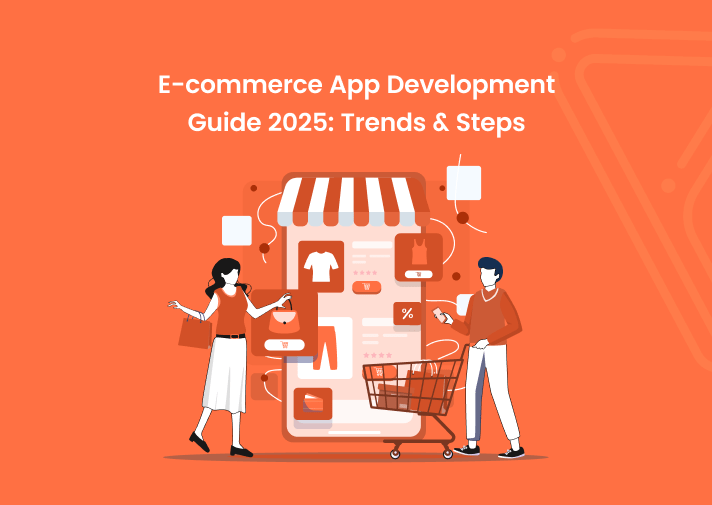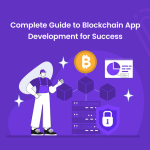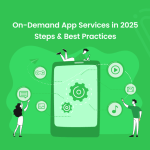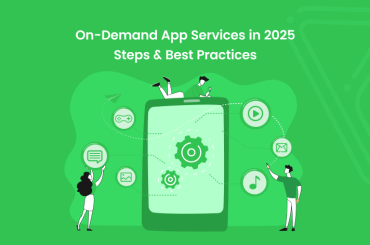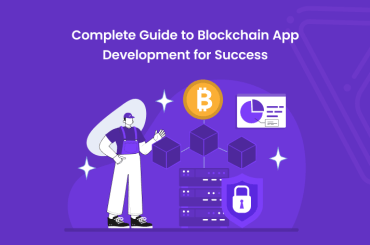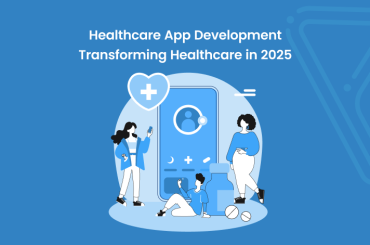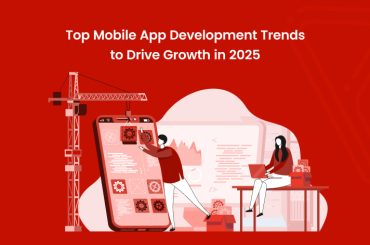Think about how often you shop online. E-commerce app development has changed how businesses connect with customers. This article will explain how these apps work, the tools used, and why design is important.
With AI and cloud trends, e-commerce apps are faster and smarter. A Mobile App Development Company in Chennai can help build feature-rich apps for a seamless shopping experience, driving business growth.
What is E-Commerce App Development?
E-commerce app development is creating apps that help businesses sell products directly to customers on their phones. These apps make shopping easy.
Today’s e-commerce apps do more than just sell. They help build trust, keep users happy, and offer a smooth experience. Giving personal suggestions makes customers feel special.
Reasons to Develop an E-Commerce App
World of Smartphones
- Smartphones are always with people, so businesses can reach them anytime.
- Mobile App Development helps businesses stay in touch with customers on their phones.
Revenue Growth
- Mobile shopping is growing fast. By 2025, most online sales will happen on phones.
- Developing a mobile app can help businesses make more sales and reach more people.
User Behavior Changes After Covid-19
- The pandemic made people shop more online, especially on phones.
- Now, mobile app development is important for businesses to keep up with shoppers.
Types of E-Commerce Apps

| E-Commerce App Type | Description | Example |
|---|---|---|
| B2C (Business-to-Consumer) | Businesses sell directly to consumers. | Amazon, Walmart, Nike |
| B2B (Business-to-Business) | Platforms for businesses to buy from other businesses. | Alibaba, Grainger, ThomasNet |
| C2C (Consumer-to-Consumer) | Consumers sell products to other consumers. | eBay, Craigslist, Poshmark |
| C2B (Consumer-to-Business) | Consumers sell products or services to businesses. | 99designs, Upwork, Shutterstock |
| Subscription-Based | Products or services are offered on a subscription basis. | Netflix, Spotify, Dollar Shave Club |
| Marketplace Apps | Platforms where multiple sellers list products. | eBay, Amazon Marketplace, Etsy |
| On-Demand E-Commerce | Apps for immediate needs, like food or ride delivery. | Uber, DoorDash, Grubhub |
| Social Commerce | Shopping through social media platforms. | Instagram Shopping, Facebook Marketplace |
| M-Commerce (Mobile Commerce) | Mobile-first shopping apps. | Shopify, Target, AliExpress |
How Voice Assistants Are Changing E-Commerce Apps
Faster Searches
- Voice assistants help users find products quickly by speaking.
- This saves time and makes shopping easier.
Easier Navigation
- Voice commands help users move around the app without tapping.
- It’s simple to search for things just by talking.
Smoother Shopping
- Voice shopping lets users buy items without using their hands.
- This makes the shopping process faster and easier.
Better Experience
- Voice features make shopping more fun and easy.
- They improve the experience by making things simple and quick.
The Role of Blockchain in Building Trustworthy E-Commerce Apps
Clear Transactions
- Blockchain keeps payment records simple and easy to check.
- It removes middlemen, so payments are faster and more accurate.
Better Security
- Blockchain protects data with strong codes to stop hacking.
- It stores data in many places to keep it safe.
Tracking Products
- Blockchain shows where a product has been, step by step.
- It proves the product is real and safe to buy.
Customer Trust
- Clear payments help customers trust a business.
- Safe products and honest records make customers happy.
E-Commerce Apps for Niche Markets: Unlocking Untapped Opportunities
Target Specific Audiences
Focusing on the right groups helps businesses sell more. It makes it easier to reach people who are likely to buy.
Live Product Demos
Live demos show how products work. This helps customers feel sure before buying.
Live Q&A
Live Q&A helps answer questions fast. It makes customers feel confident in their choices.
Influencers and Ambassadors
Small influencers reach the right people for less money. They help build trust with their followers.
Interactive Features
360-degree views and AR let customers see products before buying. This makes shopping fun and easier.
Building Community
Customer reviews help others trust products. Connecting users makes them want to buy again.
3 Key Factors to Evaluate Before Creating a Mobile E-Commerce App
Data Security
- Use strong codes to keep customer data safe.
- Update security often to protect against new threats.
- Limit who can see sensitive information to reduce risks.
Scalability
- Design your app to grow as your business gets bigger.
- Make sure it can handle more users without slowing down.
- Choose tools that can easily expand when needed.
Stability
- Test your app to find and fix bugs before they cause problems.
- Use reliable servers to keep your app running smoothly.
- Monitor performance to catch issues early and keep things working.
8 Steps to Build an E-Commerce App
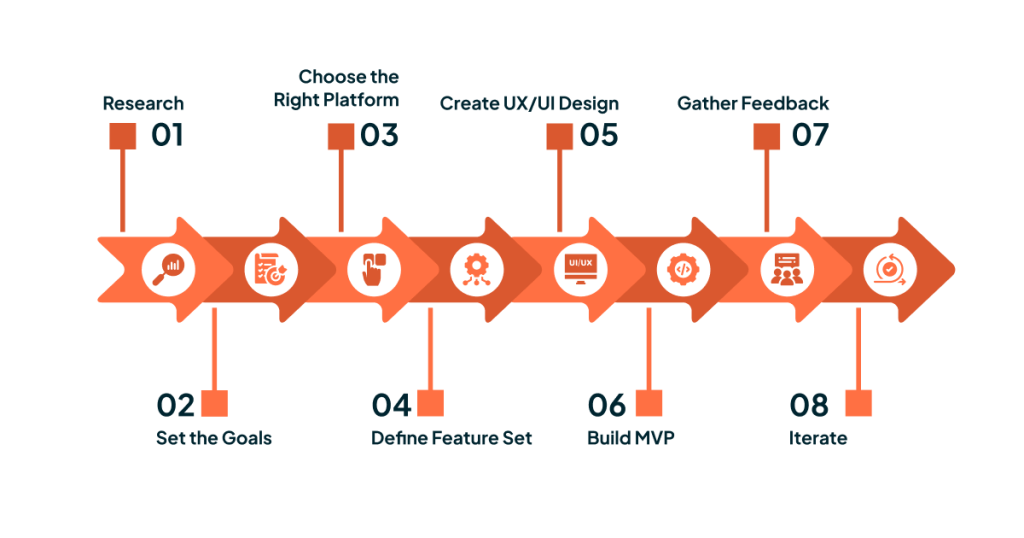
Research
- Study the market to understand what works for Android App Development or iOS App Development.
- Look at competitors to find successful features and gaps in the market.
Set the Goals
- Define clear and measurable goals for your app’s success.
- Make sure your goals align with the needs of your target users.
Choose the Right Platform
- Decide whether to develop for Android, iOS, or both.
- Each platform has its advantages, depending on your target audience.
Define Feature Set
- Focus on essential features like payment options, user profiles, and order tracking.
- Ensure the features meet the expectations of your target users.
Create UX/UI Design
- Keep the design simple and user-friendly.
- Ensure easy navigation for your platform, focusing on a seamless experience.
Build MVP
- Start with a basic version of the app to test its core features.
- Use feedback from real users to improve the app.
Gather Feedback
- Collect feedback from users to understand what they need.
- Make improvements based on real-world input to enhance the app.
Iterate
- Regularly update the app based on feedback from users.
- Continue to add new features to stay competitive in the app market.
Our Tech Stack to Develop Cutting-Edge E-Commerce Apps
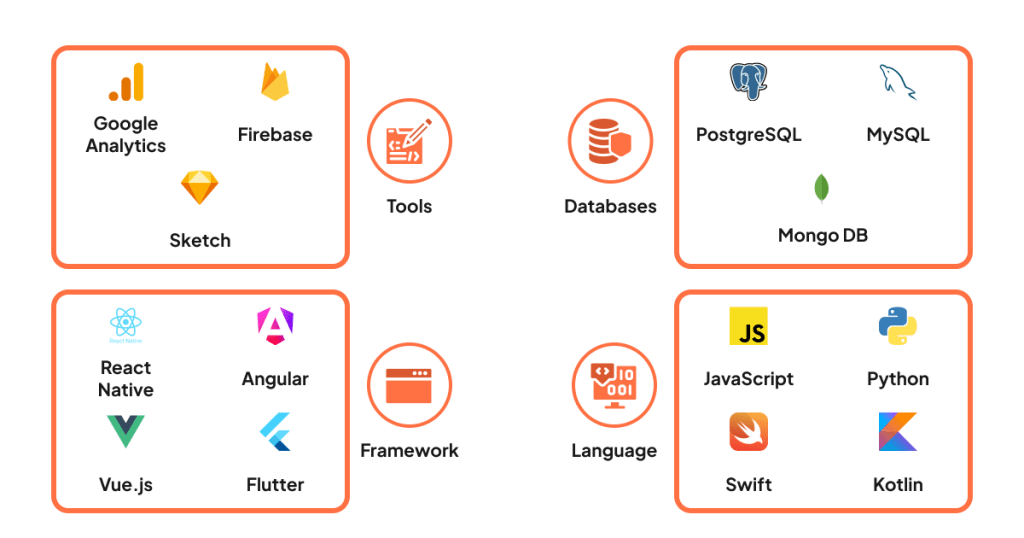
| Category | Technologies | Description |
|---|---|---|
| Languages | JavaScript, Python, Swift, Kotlin | Core languages for app performance and functionality. |
| Tools | Firebase, Google Analytics, Sketch | Tools for backend, tracking, and design. |
| Frameworks | React Native, Angular, Vue.js, Flutter App Development | Frameworks for fast, responsive, cross-platform apps. |
| Databases | MySQL, PostgreSQL, MongoDB | Reliable databases for secure and scalable data management. |
Microservices-Based E-Commerce Web and App Development
Flexibility
- Microservices break the app into smaller parts, making it easier to update and change.
- Each part can be changed without affecting the whole app.
- You can scale each part of the app as needed, saving resources.
Scalability
- Microservices help you grow parts of the app based on how many users you have.
- It’s easier to add more resources for busy times or when the app grows.
- You can scale the app without affecting other parts, making it cost-effective.
Teamwork
- Teams can work on different parts of the app at the same time.
- This speeds up development and reduces mistakes.
- Teams can pick the best tools for each part of the app, improving performance.
Easy Updates
- You can update parts of the app without changing the whole thing.
- It’s less risky because only smaller parts are affected.
- Bugs can be fixed faster in one section without stopping the rest of the app.
Long-Term Growth
- Microservices help your app stay flexible and ready for new changes.
- You can add new features or grow the app as needed.
- They help the app keep up with changes in technology over time.
Challenges and Benefits in E-Commerce Apps
Challenges
- Technology Selection: Picking the right tech helps the app work smoothly.
- Stability: The app must work well, even with many users.
- Unified Shopping Experience: The app needs to work the same on phones and computers.
- Analytics: Tracking what customers do helps make the app better.
- Multi-Vendor Marketplace Solution: Managing many sellers can be hard.
- Data Security: Protecting customer data is very important.
Benefits
- 100% Customization: The app can be changed to meet your business needs.
- Source Code Authority: You control the app’s code, which makes it safer.
- Contemporary UI/UX: A good UI/UX Design makes the app easy to use.
- Top-Class Quality: High-quality features make the app better for users.
- Real-Time Interaction Solutions: Chat and notifications help keep customers engaged.
- Future Maintenance & Support: Regular updates keep the app fresh and useful.
E-Commerce App Development Trends
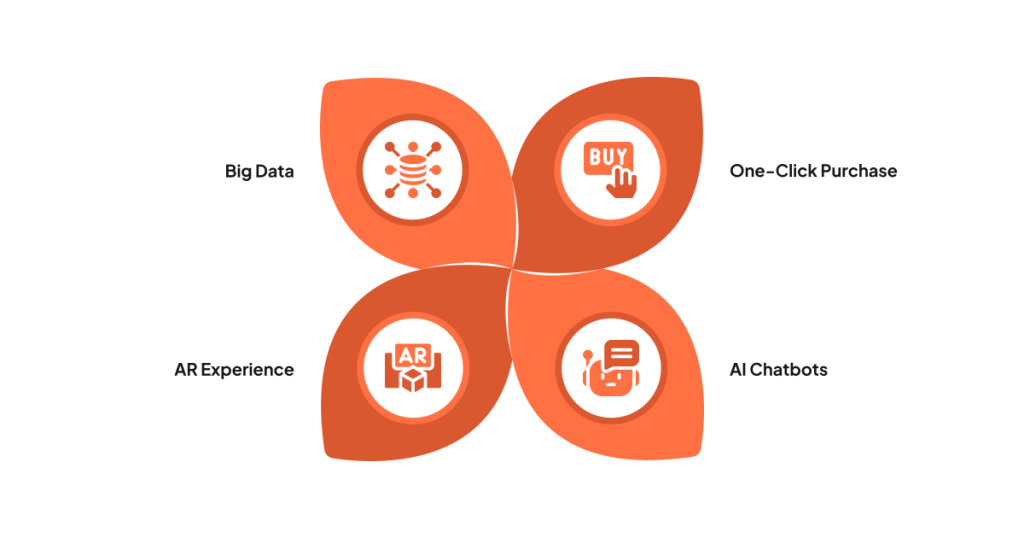
Big Data
- Big data helps make shopping more personal by knowing what customers like.
- It helps businesses choose the right products based on customer habits.
- Businesses can send ads that match what customers want.
AR Experience
- Augmented reality shows how products look in real life before buying.
- It helps customers see if a product will work for them.
- AR can help reduce returns by showing what fits or looks right.
One-Click Purchase
- One-click purchase lets customers buy with just one tap.
- It makes buying faster and helps reduce cart abandonment.
- Customers don’t need to fill in details each time, making it easier.
AI Chatbots
- AI chatbots quickly answer customer questions.
- They suggest products based on what the customer likes.
- Chatbots help businesses by handling simple questions and saving time.
Cost of E-Commerce App Development
| Cost Factor | Description | Estimated Cost Range |
|---|---|---|
| Development | Includes designing and coding the app. | $10,000 – $100,000+ |
| Features | Costs vary with complexity (payment systems, etc.). | $5,000 – $50,000+ |
| Maintenance | Regular updates, bug fixes, and system checks. | $1,000 – $10,000 annually |
| Platform Choice | iOS, Android, or both (native or hybrid). | $5,000 – $40,000+ |
| Design | UX/UI design for a seamless user experience. | $2,000 – $15,000+ |
| Security | Secure payment gateways and data protection. | $1,000 – $10,000+ |
| Hosting & Server Costs | Cost to host and maintain the app. | $500 – $5,000 annually |
E-Commerce Success Stories
1. Amazon
Overview: Amazon’s app made shopping easy with one-click buying and product suggestions.
Impact: This helped Amazon become the most popular online store, with millions of new users every year.
Key Takeaway: Amazon’s simple and easy-to-use app changed online shopping for everyone.
2. Shopify
Overview: Shopify helps people set up online stores easily with simple tools.
Impact: It allowed small businesses to sell online and helped them grow.
Key Takeaway: Shopify made online selling simple, helping businesses succeed.

Conclusion
In conclusion, picking the right tech for your e-commerce app development is important. Native, hybrid, or cross-platform each has its benefits. Think about how your app works, your budget, and how it will grow.
Tech changes fast, so stay updated to keep your e-commerce app ahead. Not sure which tech is best for your e-commerce app development? Pyramidion Solutions can help. Contact us for expert advice and custom solutions.

As the Director of Business Development, I have provided top-notch IT solutions for over a decade for software development, mobile application development, and blockchain development. My main work and passion lie in contributing to the business’s success through knowledge, creativity, hard work, and strong organizational skills.

